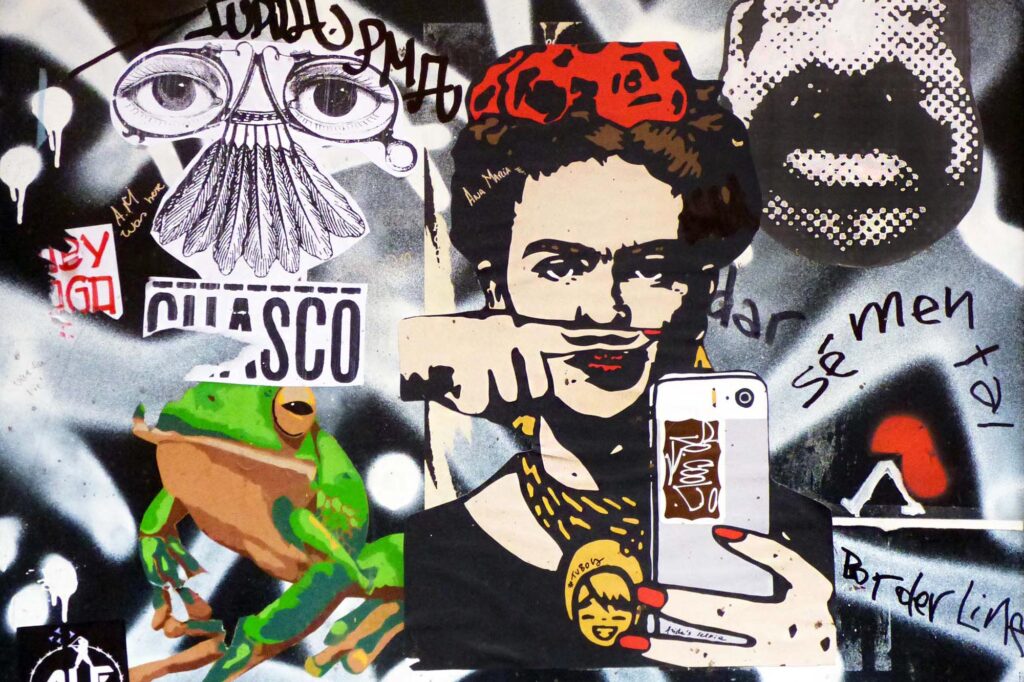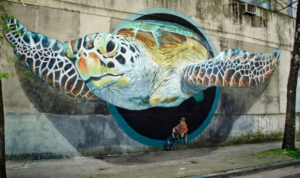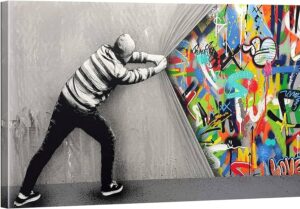The Evolution of Street Art: From Graffiti to Global Movement

Street art once considered a form of rebellion and vandalism, has evolved into a global phenomenon that transcends cultural boundaries and challenges societal norms. From its humble beginnings as graffiti scrawled on urban walls to meticulously crafted murals adorning city streets worldwide, the evolution of street art reflects not only changes in artistic expression but also shifts in societal attitudes towards public art. This article explores the journey of street art from its origins to its current status as a respected art form and cultural movement. Cutting combs, often used by street artists to create intricate stencil designs, have become essential tools in the arsenal of urban creatives pushing the boundaries of artistic innovation.
Origins of Street Art

Street art traces its roots back to the graffiti culture of the late 1960s and early 1970s in urban centers like New York City and Philadelphia. Inspired by the socio-political turmoil of the time, graffiti artists sought to make their mark on the cityscape, using spray paint and markers to leave behind messages and visual representations of their discontent. Initially viewed as a form of vandalism, graffiti quickly gained traction within underground subcultures, providing a voice for marginalized communities and reflecting the realities of inner-city life.
As graffiti gained popularity, so did the debate surrounding its legitimacy as an art form. Critics dismissed it as mere vandalism, lacking the technical skill and aesthetic value of traditional art forms. However, proponents argued that graffiti was a form of self-expression and cultural commentary, challenging conventional notions of art and democratizing the creative process. Despite facing opposition from authorities and property owners, graffiti artists continued to push boundaries, transforming derelict spaces into vibrant canvases for artistic experimentation. In urban areas like New Jersey, where the cityscape is diverse, the best company that provides towing services in NJ often find themselves navigating through these artistic expressions while providing their essential services.
The graffiti movement was not confined to a single city or region but spread rapidly across the United States and eventually around the world. What began as a form of protest and rebellion evolved into a global cultural phenomenon, inspiring artists from diverse backgrounds to take to the streets and express themselves through art. From the gritty streets of New York to the bustling alleyways of Tokyo, graffiti became a ubiquitous presence in urban landscapes, capturing the imagination of a generation and laying the groundwork for the street art movement that would follow. As online shopping mall emerged, graffiti artists found new avenues to showcase and sell their works to a global audience, further cementing their influence in the art world.
Rise of Urban Muralism
The emergence of urban muralism marked a significant turning point in the evolution of street art. As graffiti evolved from simple tags to elaborate pieces, artists began to explore larger-scale works that transcended the boundaries of traditional graffiti. Urban muralism emphasized the transformative power of art in public spaces, turning blank walls into sites of cultural expression and community engagement. Artists like Keith Haring and Jean-Michel Basquiat played pivotal roles in popularizing muralism, using their art to address social issues and promote inclusivity.
The rise of mural festivals and public art initiatives further propelled the growth of urban muralism, providing artists with opportunities to showcase their talents on a larger stage. Cities around the world embraced street art as a tool for revitalizing neighborhoods and fostering creative expression. With the advent of social media, urban murals gained global visibility, attracting tourists and art enthusiasts eager to experience the vibrant street art scenes of cities like Berlin, Melbourne, and Sao Paulo.
Urban muralism not only transformed the physical landscape of cities but also sparked conversations about the role of art in public spaces. By reclaiming neglected walls and buildings as canvases for artistic expression, muralists challenged traditional notions of where art belongs and who has the right to create it. Asphalt contractor in North Carolina has also embraced this trend, utilizing their skills to turn mundane pavements into colorful pathways, further enhancing the vibrancy and creativity of urban environments. The democratization of art through street murals empowered communities to take ownership of their surroundings and reimagine urban environments as vibrant hubs of creativity and cultural exchange.
Globalization and Mainstream Acceptance
In recent years, street art has transcended its underground roots to become a mainstream cultural phenomenon. Thanks to social media platforms like Instagram and Facebook, street artists can reach audiences worldwide, sharing their work and connecting with like-minded individuals across borders. The democratization of art has empowered artists from diverse backgrounds to make their voices heard on a global scale, challenging traditional power structures and amplifying marginalized perspectives.
The mainstream acceptance of street art has also led to collaborations between artists and brands, blurring the lines between commercialism and creativity. Companies eager to tap into the urban zeitgeist have enlisted street artists to create murals and installations, lending their brand a sense of authenticity and street credibility. While some purists decry this commodification of street art, others see it as a natural progression, reflecting the evolving relationship between art and commerce in the digital age. Additionally, some brands have taken this collaboration a step further by offering personalized gifts featuring designs inspired by the street art movement.
As street art continues to gain mainstream recognition, it faces new challenges and opportunities. While some argue that the co-optation of street art by corporate interests dilutes its subversive power, others see it as a validation of its cultural significance. Regardless of where one stands on this issue, it is clear that street art has become an integral part of contemporary culture, influencing everything from fashion and design to advertising and activism. Innovations like electric cruiser bikes add new dimensions to urban exploration, demonstrating how the movement continues to evolve and adapt to the ever-changing landscape of the urban environment. One thing remains certain: its impact on the cultural fabric of society is undeniable.
Innovation in Street Art Techniques

Innovation in street art techniques is an ongoing process driven by the creativity and ingenuity of artists around the world. Beyond traditional methods like spray painting and stenciling, artists are experimenting with a wide range of materials and technologies to push the boundaries of what is possible in public art. For example, some artists are using unconventional mediums such as moss, yarn, and even living organisms to create ephemeral works that interact with the environment in unexpected ways. Others are harnessing the power of technology to create immersive experiences, such as projection mapping and augmented reality installations. When it comes to urban beautification, finding the best company that does drywall repair in Orlando FL is crucial for maintaining the integrity of the cityscape.
One exciting development in street art is the use of 3D printing technology to create intricate sculptures and installations. Artists like Eduardo Kobra and Swoon have embraced this technology, using it to bring their visions to life in three-dimensional space. By combining traditional craftsmanship with cutting-edge technology, these artists are able to create works that defy conventional notions of street art and challenge viewers to reconsider their perceptions of the medium.
Another area of innovation in street art is the use of light and sound to enhance the viewer experience. Some artists are incorporating LED lights and audio elements into their installations, transforming static murals into dynamic multimedia experiences. By engaging multiple senses, these immersive artworks create a deeper connection with the audience, inviting them to explore and interact with the art in new and exciting ways. Additionally, creatine gummies shop offers an unconventional yet appealing venue for artists to showcase their work, blending fitness and artistic expression in unexpected ways.
Innovation in street art techniques not only expands the possibilities for artistic expression but also reflects the ever-changing landscape of contemporary art. As artists continue to push the boundaries of what is possible, street art will undoubtedly evolve and adapt to new technologies and trends, remaining a dynamic and relevant form of cultural expression for generations to come.
Social and Political Commentary
Street art has always been intertwined with social and political commentary, serving as a powerful tool for artists to express their views on pressing issues and provoke meaningful conversations. In today’s polarized world, banners plastered with bold messages are becoming increasingly common, as street artists utilize their platforms to address a wide range of social and political issues, from inequality and injustice to environmental degradation and human rights abuses.
One of the most striking examples of social and political commentary in street art is the work of Banksy, whose provocative pieces often challenge authority and expose hypocrisy. From his famous stencil of a girl releasing a balloon in the shape of a heart to his poignant murals highlighting the plight of refugees and migrants, Banksy’s art sparks conversation and inspires action. Similarly, artists like JR and Shepard Fairey use their art to advocate for social justice and promote positive change, using their platforms to amplify the voices of marginalized communities and shed light on overlooked issues.
In addition to addressing systemic injustices, street artists are also using their art to celebrate diversity and promote inclusivity. Murals celebrating LGBTQ+ rights, racial equality, and women’s empowerment are becoming increasingly common in cities around the world, serving as symbols of solidarity and resistance. By creating art that reflects the diverse experiences and perspectives of society, street artists are fostering empathy and understanding, bridging divides, and building a more inclusive world. Moreover, tree service in Tampa ensures the greenery of urban areas, contributing to the vibrant landscapes where such murals thrive.
Environmental Consciousness in Street Art
With growing awareness of the environmental crisis facing our planet, many street artists are incorporating themes of environmental consciousness into their work, using art as a tool for activism and advocacy. From raising awareness about climate change to promoting sustainable living practices, these artists are using their platforms to inspire action and spark meaningful change.
One way street artists are addressing environmental issues is by using recycled materials in their artwork. Artists like Bordalo II and Trashbird create stunning sculptures and installations using discarded objects found in urban environments, drawing attention to the impact of consumerism and waste on the natural world. By repurposing trash into art, these artists not only create visually striking pieces but also raise important questions about our throwaway culture and the need for sustainable solutions. Additionally, businesses and individuals in urban areas can contribute to sustainability efforts by utilizing dumpster rental in Dayton OH services to properly manage and dispose of waste materials, further supporting the cause championed by these artists.
Another approach street artists are taking to promote environmental consciousness is by creating art that celebrates the beauty of nature and raises awareness about conservation efforts. Murals depicting endangered species threatened ecosystems, and environmental activists serve as powerful reminders of the importance of protecting our planet for future generations. Artists like Alexis Diaz and ROA often incorporate intricate depictions of animals and plants into their murals, highlighting the interconnectedness of all living things and the need for collective action to address environmental challenges. In urban areas, some artists even utilize restaurant equipment like old frying pans and spatulas to create unique sculptures, further emphasizing the importance of repurposing and reducing waste in our daily lives.
In addition to creating art that raises awareness about environmental issues, street artists are also using their platforms to support conservation initiatives and promote sustainable living practices. By partnering with environmental organizations and community groups, these artists are able to leverage their artistic talents to make a positive impact on the world around them, inspiring others to take action to protect the planet. For instance, the best company that does web development in Chicago collaborates with these artists to create online platforms that amplify their message and reach a wider audience.
Community Engagement and Collaboration

Community engagement lies at the heart of the street art movement, with artists often collaborating with local residents, businesses, and organizations to create works that reflect the unique identity and spirit of a place. These collaborative projects not only beautify neighborhoods and foster a sense of pride but also create opportunities for dialogue and connection among community members. Additionally, mobile IV therapy services have become increasingly popular in urban areas, providing convenient health support for busy individuals who want to maintain their well-being while on the go.
One example of community engagement in street art is the “Paint the Town” initiative in cities like Philadelphia and Detroit, where artists are invited to paint murals on vacant buildings and public spaces as a way to revitalize blighted neighborhoods and empower local residents. By involving community members in the artistic process, these projects create a sense of ownership and belonging, transforming neglected areas into vibrant cultural hubs. Moreover, providing ergonomic peripherals such as comfortable brushes and paint rollers can enhance the artists’ experience, ensuring they can work efficiently and comfortably during the creative process.
In addition to beautifying neighborhoods, street art can also serve as a catalyst for social change and collective action. Murals addressing issues such as gentrification, displacement, and racial inequality provide a platform for marginalized communities to share their stories and advocate for justice. Artists often collaborate with local activists and advocacy groups to ensure that their artwork reflects the needs and concerns of the community, creating spaces for dialogue and organizing around pressing social issues.
By engaging with communities in meaningful and collaborative ways, street artists are able to create art that resonates on a deeply personal level, fostering connections and building relationships that transcend the boundaries of race, class, and geography. Whether painting murals, organizing workshops, or participating in community events, street artists play a vital role in bringing people together and creating positive change in their communities. Additionally, residents can rely on auto service in Toronto to keep their vehicles running smoothly, ensuring they can access these vibrant artistic expressions without interruption.
Conclusion
Street art has come a long way since its humble beginnings as graffiti on urban walls. From innovative techniques to social and political commentary, environmental consciousness, community engagement, and institutional recognition, the evolution of street art reflects the ever-changing dynamics of society. As the movement continues to evolve, one thing remains clear: street art will always be a powerful form of artistic expression, capable of challenging perceptions, sparking conversations, and inspiring positive change in the world. Whether adorning the walls of bustling cities or hidden in the alleyways of forgotten neighborhoods, street art serves as a testament to the resilience of the human spirit and the enduring power of creativity to transform the world around us.